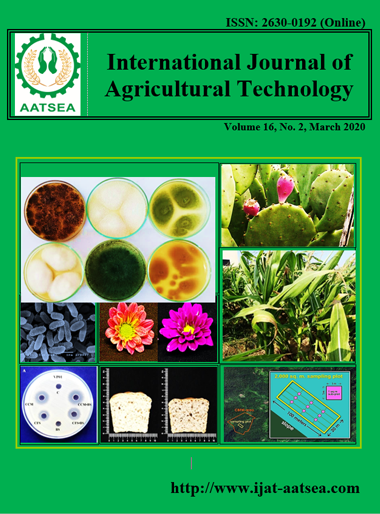Shifting and dominance of weed species following solarization treatment under organic farming system in tropical highland
Main Article Content
Abstract
Weed control is essential to improve plant productivity under an organic farming system. This practice often leads to shifting of weed species. The experiment confirmed that two-month solarization treatment brought about the alteration of weed species, but the number of weed species was not significantly different, approximately fifteen species for each treatment. Solarization treatment led to weed shifting and dominance from grass to broadleaf weeds. Red plastic mulch shifted Blumea lacerna dominance to Ricardia brasiliensis at 0-5 cm depth. Meanwhile, at 10-15 cm soil depth, the dominance of Eleucine indica was shifted into Bidens pilosa. Mulch treatment substantially reduced the number of weed population to the depth of 15 cm from the soil surface. After two months of solarization, clear plastic mulch is the most effective to reduce weed dry weight. Solarization significantly decreased weed dry weight by approximately 30, 60 and 65 % in treatments using silver black, black, and clear plastic mulch respectively in comparison to the control.
Article Details

This work is licensed under a Creative Commons Attribution-NonCommercial-NoDerivatives 4.0 International License.
References
Bond, W., Turner, R. J. and Grundy, A. C. (2003). A Review of non- chemical weed management, HDRA. The Organic Organization. http://www.organicweeds.org.uk.
Diaz-Perez, J. C. and Batal, K. D. (2002). Colored plastic film mulches affect tomato growth and yield via changes in root-zone temperature. Journal of American Society of Horticulture Science 127:127-136.
Elmore, C. L. (2012). Effect of soil solarization on weeds. Department of Botany, University of California, Davis, USA.
Elmore, C. L., Stapleton, J. J., Bell, C. E. and Devay, J. E. (1977). Soil solarization: A non-pesticidal method for controlling diseases, nematodes and weeds. Vegetable Research and Information Center. University of California, USA.
Golzardi, F., Vaziritabar, Y., Sarvaramini, S. and Ebadi, S. Z. (2014). Solarization period and thickness of polyethylene sheet effects on weed density and biomass. Indian Journal of Fundamental and Applied Life Sciences, 4:587-593.
Harsono, P., Soedarsono, J., Tohari and Shiddieq, J. (2009). Pengaruh macam mulsa terhadap sifat-sifat tanah vertisol. Jurnal penelitian Teh dan Kina, 12:1-8.
Horowitz, M., Regev, Y. and Herzlinger, G. (1983). Solarization for weed control. Weed Science, 31:170-179. doi:10.1017/S0043174500068788.
Ibarra-Jimenez, L., Lira-Saldivar, R. H., Valdez-Agnilar, L. A. and Lozano-Del Rio, J. (2011). Colored plastic mulches affect soil temperature and tuber production of potato. ActaAgriculturae Scandinavica, 61.
Johnson, M. S. and Fennimore, S. A. (2005). Weed and crop response to colored plastic mulches in strawberry production. HortScience, 40:1371-1375.
Khan, I. A., Ullah, Z. and Daur, I. (2013). Comparison of different weed control techniques in maize. Global Journal of Science Frontier Research Agriculture and Veterinary, 13:13-15.
Khan M. A., Marwat, K. B., Amin, A., Nawaz, A., Khan, R., Khan, H. and Shah, U. (2012). Soil solarization: An organic weed management approach in cauliflower. Communication in Soil Science and Plant Analysis, 43:1847-1860.
Linke, K. H., Saxena, M. C., Sauerborn, J. and Masri, H. (1991). Effect of soil solarization on the yield of food legumes and on pest control. FAO Plant Production and Protection Paper 1991 No.109 pp.139-154.
Marquez, J. and Wang, K. (2014). Soil solarization as an organic pre-emergent weed- management tactic. College of Tropical Agriculture and Human Resourches. University of Hawaii at Manoa.
Osman, M. A., Raju, P. S. and Peacock, J. M. (1991). The effect of soil temperature, moisture and nitrogen on Striga asiatica (L.) Kuntze seed germination, viability and emergence on sorghum (Sorghum bicolor L. Moench) roots under field conditions. Plant Soil, 131:265. DOI:10.1007/ BF00009458.
Peachey, R. E., Pinkerton, J. N., Ivors, K. L., Miller, M. L. and Moore, L. W. (2001). Effect of soil solarization, cover crops, and metham on field emergence and survival of buried annual bluegrass (Poa annua) Seeds. Weed Technology, 15:81-88. DOI: 10.1614/0890-037X(2001)015[0081:EOSSCC]2.0.CO;2.
Rajablariani, H. R., Hassankhan, F. and Rafezi, R. (2012). Effect of colored plastic mulches on yield of tomato and weed biomass. International Journal of Environmental Science and Development, 3:590-593.
Setyowati, N., Nurjanah, U., Sudjatmiko, S., Muktamar, Z., Fahrurrozi, F. and Chozin, M. (2017a). Soil solarization with color plastic mulch influences weed growth and soil temperature in tropical highland. International Journal of Agricultural Technology, 13:2053-2063.
Setyowati, N., Nurjanah, U., Muktamar, Z., Fahrurrozi, F., Chozin, M. and Sudjatmiko, S. (2017b). Weed seed inhibition under solarization treatment with different mulch color in tropical highland organic farming system. International Journal on Advanced Science Engineering Information Technology, 7:1894-1899.
Singh, A. K. and Kamal, S. (2012). Effect of black plastic mulch on soil temperature and tomato yield in mid hills of Garbwal Himalayas. Short Communication. Journal of Horticulture and Forestry, 4:78-80.
Soerjani, M., Jahja, A., Kostermans, G. H. and Tjitrosoepomo, G. (1987). Weed of Rice in Indonesia. Regional Center for Tropical Biology. Bogor. Indonesia.
Stapleton, J. J. (2000). Soil Solarization in various agricultural production system. Crop Protection, 19:837-841.
Sahile, G., Abebe, G. and Al-Tawaha, A. M. (2005). Effect of soil solarization on orobanche soil seed bank and tomato yield in central rift valley of Ethiopia. World Journal of Agricultural Sciences, 1:143-147.


